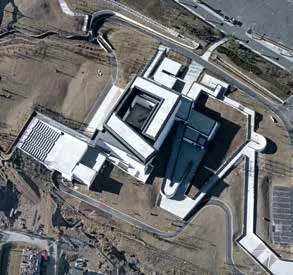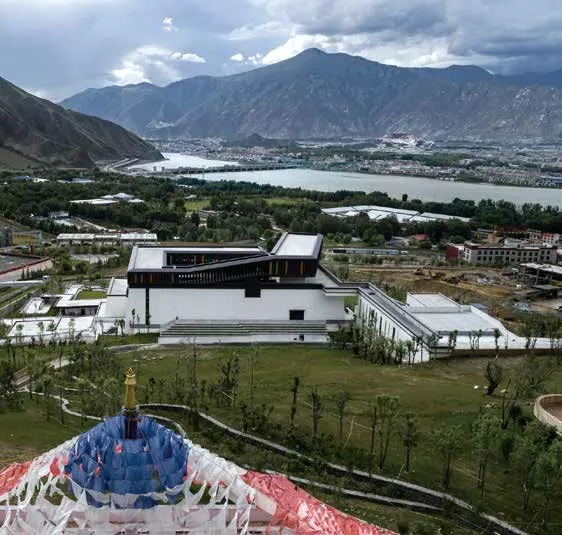天路
——西藏非物质文化遗产博物馆 西藏拉萨市慈觉林片区
2021-12-28廖国威,朱琳,梁子毅等
业主:西藏自治区拉萨市政府/深圳市政府/万科集团
规划及建筑设计:深圳华汇设计有限公司
主创建筑师:肖诚
设计团队:廖国威,朱琳,梁子毅,梁鉴源,徐牧,湛吉高,杨晶,李燕玲
占地面积:40,000平方米
建筑面积:8,000平方米
设计/建成时间:2016年/2018年
建筑类型:文化博物馆
结构形式:钢结构+钢筋混凝土+局部石砌
施工图设计:中国建筑西南设计研究院
景观设计:朱育帆工作室
室内设计:深圳共和设计
摄影:姚力
Client:Lhasa municipal government of Tibet Autonomous Region/ Shenzhen Municipal Government/ Vanke Group
Planning and Architecture Design:Shenzhen Huahui Design
Principal Architect:Xiao Cheng
Project Team:Liao Guowei,Zhu Lin,Liang Ziyi,Liang Jianyuan,Xu Mu,Zhan Jigao,Yang Jing,Li Yanling
Area:40,000m2
Total construction area:8,000m2
Design/Completion time:2016/2018
Building Type:Culture,Museum
Structure and Material:Reinforced concrete structure,Local masonry,Steel structure
LDI:CSCEC
Landscape Design:Atelier Zhu Yufan
Interior Design:Gonghe Design
Photography:Yao Li
项目位于海拔近4000m 的拉萨城南,北望布达拉宫,南靠宝瓶山,地势自南向北平缓降低,建成之后从整个拉萨河谷和布达拉宫都可以清晰地看到它。整个项目由建筑面积约8000 平方米的博物馆和40000 平方米的博览园两个部分组成,非遗博物馆是主体建筑,内设立展厅、庭院、剧场、办公、天台、瞭望厅等功能空间。
The project is located in the south of Lhasa,with an elevation of nearly 4000m,looking at the Potala Palace in the north and lying back against the Potala Mountain in the south.The terrain drops gently from south to north,and can be clearly seen from the whole Lhasa Valley and the Potala Palace.The whole project consists of a museum with a floor area of about 6,800 square meters and an exhibition garden with a floor area of 40,000 square meters.The intangible cultural Heritage Museum is the main building,with exhibition halls,courtyards,theaters,offices,rooftop,observation halls and other functional spaces.
为了更好地表现西藏非物质文化遗产,设计以藏地特有的空间概念——“天路”为原点:进入博物馆、园林的路径,既是体验自然环境的天路,又是感受建筑空间、遗产宝藏、民族文化的人路,更是通过转折攀升、明暗交替的空间体验,最终达至澄澈空灵之境、对望布达拉宫的心路。
In order to better exhibit the intangible cultural heritage in Tibet,we had better select the unique space concept in Tibet — Heaven Road as the origin of the design:Stepping on the path into the museums and parks,you will find such a path actually a Heaven Road where you can experience the sky road of the natural environment and feel the man’s road of building space,heritage treasure and national culture,still more achieve clarity and intangibility and face Potala Palace through turning,climbing,alternation of brightness and darkness.This path closely integrates the grandness of Potala Palace,the inside of Jokhang Temple and the abundance of Norbulingka.
参观者经过艰苦的攀爬,一路领略藏地丰富的非物质文化遗产,最终达成和布达拉宫跨越时空的对望。这是一种对话,更是一种致敬,是向西藏伟大的自然地理和历史文化致敬,也是向每个人心中的那片圣地致敬。
抽样数据表明,本题的得分率仅为0.16.学生在答题时表述不规范、推理不严密;学生无法提取和使用图形中的有效信息,识图、想图、用图能力很弱,不能充分观察研究出所给图形中的几何元素的相互关系;即使能够观察研究出相互关系,也不能将图形语言转化为文字和符号语言,更不能利用文字和符号语言刻画图形的相关性质.
Walking among them,you will see a colorful grand-spectacle on living on the Tibetan land,in which are included the forest and vegetation,dancing and singing theater,terraced gardens,miniature landscape,festival place,meditation water courtyard.As long as you follow the sky road,you can dig out that Tibetan culture can wonderfully be played back in the modern way.


形态生成 Morphogenesis


西藏非物质文化遗产博物馆是由深圳市政府与万科集团出资,并由万科代建的深圳支援西藏自治区的重点项目。
项目基地位于新开发的慈觉林文创园区,地处由拉萨河谷向南延伸形成的平缓地带,向北与拉萨老城隔河谷相望,而东西南三面,则被山体环抱。
我们希望这座博物馆能成为西藏新的文化地标,同时能以友善的姿态融于现有的自然环境和城市肌理之中;另一方面也能与布达拉宫、大昭寺等西藏重要的历史建筑产生文脉上的共生关系,从而形成一种跨越时空的对话。
在拉萨这座及其特殊的城市中,自然与人文、历史与当下的种种要素相互交汇叠加,形成了我们设计的特定条件和思考原点。
西藏是人们心中接近天空的圣地,布达拉宫和大昭寺更是朝圣的目的地。“天路”作为项目的基本设计概念,暗合了藏地最独特的自然和文化基因。
在设计之中,“天路”概念体现为三个层面:首先是物理层面的行走路径,它提取自布达拉宫之字形步道的原型,经过抽象的演绎,构成了从场地入口迂回上升进入建筑,以及在博物馆内部螺旋攀升的基本空间动线。
其次是空间叠加带来的特殊体验的路径:博物馆建筑原型从大昭寺主殿演化形成,当这种内向而稳定的空间结构和由天路概念形成的参观路径相叠加后,则在人与物理空间之间形成了非常多样化的关系,或高狭,或开阔,或幽暗,或明朗,仿佛在经历一段特殊的生命旅程。
而这种特殊的空间经验自然而然地引发了人们心理和情感层面的微妙变化,就成为“天路”的第三重意义——心路。
参观者经过艰苦的攀爬,一路领略了藏地丰富的非物质文化遗产,最终达成和布达拉宫的跨越时空的对望。这是一种对话,更是一种致敬,是向西藏伟大的自然地理和历史文化致敬,也是向每个人心中的那片圣地致敬。



The Tibet Intangible Cultural Heritage Museum is funded by the Shenzhen Municipal Government and Vanke Group,and built by Vanke on behalf of Shenzhen to support key projects in the Tibet Autonomous Region.
The site of the building is located in the newly developed Cijuelin cultural and creative park,which is on a slight slope extending from the Lhasa river valley facing the old city of Lhasa across the river to the north,and surrounded by mountains on east,west and south sides.
We hope the building can be integrated into the existing natural environment and urban texture with a friendly attitude and will become a new cultural landmark in Tibet. Meanwhile,it can also be associated with the important history buildings of Tibet such as the Potala Palace and the Jokhang Temple,creating a symbiotic relationship in the context,and form a dialogue with them across time and space.
Lhasa is a very special city.The elements of nature and humanity,history and modernity are interwoven with each other,which form the specific conditions of our design and the key point of our thinking.
In people's mind,Tibet is a holy place close to the sky .The Potala Palace and Jokhang Temple are pilgrimage destinations.We take "heaven road" as the basic design concept,which is consistent with the most unique nature and cultural genes here.
The concept of "heaven road" is embodied in three levels:firstly,in physical level,it means the walking path,which is extracted from the prototype of zigzag footpath of Potala Palace.It forms a rising spatial circulation from the entrance of the site to the building and spiraling up inside the museum.
Secondly,It means a unique experience of space.The main volume of the museum is evolved from the main hall of the Jokhang Temple,which forms an introverted and stable space.when the space is connected along with the touring path of the “heaven road",It creates a diversified spatial experience that makes people feel tall,narrow,open,dark,or bright in different public space or exhibition rooms.This unique spatial experience also can be seemed as a reflection of a special journey of life.





The mapping from the spatial experience level to the emotional level brings subtle changes in the human heart,that is the third meaning of "heaven road" — a road of heart.
After visitors appreciate the rich intangible cultural heritage of Tibet in the building through a hard climb,they will finally reach the ending point where they can overlook the Potala Palace,the sense of distance and direction forms a dialogue across time and space.It is not only a dialogue but also a tribute -a tribute to the great natural geography,history and culture of Tibet,as well as to the holy land in everyone's heart.



轴测图 Axon

